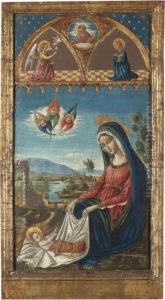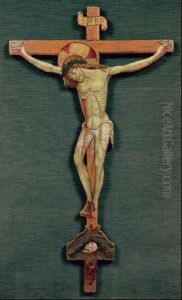Niccolo Foligno Da Alunno Paintings
Niccolò di Liberatore, commonly known as Niccolò Alunno or Niccolò da Foligno, was a notable figure in the Italian Renaissance, born in 1430 in Foligno, a small town in the Umbria region of Italy. His nickname 'Alunno' (meaning student or pupil in Italian) is somewhat misleading, as he was a master painter of his time, deeply influenced by the Umbrian school of painting, which was known for its devout spirituality and keen attention to detail. Niccolò's works are characterized by their vivid color, emotional intensity, and intricate detail, emblematic of the transition between the Gothic and Renaissance styles.
Niccolò's early life is somewhat obscure, but it is believed that he was trained in the workshop of Bartolomeo di Tommaso, a painter from Foligno. His career spanned over five decades, during which he produced a significant number of altarpieces and frescoes, many of which have survived to this day. His style was influenced by the works of Fra Angelico and Benozzo Gozzoli, and he played a crucial role in the dissemination of the Renaissance style in Umbria. Niccolò was not just a painter; he was also involved in the social and religious life of Foligno, participating in the confraternity of Santa Maria Infraportas and contributing to the cultural and spiritual life of the community.
One of Niccolò's most famous works is the Annunciation with St. Michael and St. Raphael, and the Eternal in Glory (c. 1470), which showcases his skill in using perspective and his ability to depict divine figures with a sense of humanity and emotion. Another significant work is the polyptych for the church of San Nicolò in Foligno, which demonstrates his mastery over narrative storytelling through images. Throughout his career, Niccolò’s art evolved, showing an increasing interest in landscape and the natural world, reflecting broader trends in Renaissance art towards realism and the study of nature.
Niccolò Alunno's legacy is that of a pivotal figure in the Umbrian school, who bridged the Gothic and Renaissance styles and influenced a generation of painters in central Italy. His devotion to religious themes and his community left a lasting impression on the art and culture of Umbria. He died in 1502 in Foligno, leaving behind a body of work that continues to be studied and admired for its beauty and emotional depth. His contributions to Italian Renaissance art are celebrated for their spiritual intensity and technical mastery, securing his place as one of the era's most significant artists.

